When I first started playing pickleball, my learning curve was fairly basic. But as I improved, and played the game more, I started implementing pickleball tips for intermediate players and my skill level took off!
The top two pickleball tips for intermediate players that I recommend to any player are hitting at your opponent’s backhand and hitting at their feet when at the net. Those two tactics will undoubtedly win you more points.
While these two intermediate-level tips have won me more games, there are actually many tips for intermediate players that you can implement immediately.
In this post, I’m going to outline 11 pickleball tips for intermediate players that have made me a better player over the last year and a half. The goal of this post is to outline each one and make you a better player the next time you step out onto the court.
Editor’s Note: I recommend starting here if you’re more on the beginner side of things.
Tip #1 – Serves and Return Of Serve Should Always Land In
Ask any advanced player who plays competitively, they only get one serve or return of serve that is allowed to fall dead in the net over the course of an entire game. Intermediate players don’t make beginner-level mistakes like blasting a serve or return of serve into the net.
Unforced errors are not tolerated by intermediate players. Period.
So whether you’re serving or returning the serve, the ball should never hit the net or fly out of bounds. These first two shots should be automatic and always be in play. No serve or return of serve should ever land out.
These are the two most basic shots in the game of pickleball and intermediate players know they should always land in. Otherwise, you’re gifting your opponents points they didn’t even need to work for.
Tip #2 – The Serve and Return Of Serve Should Always Be Deep
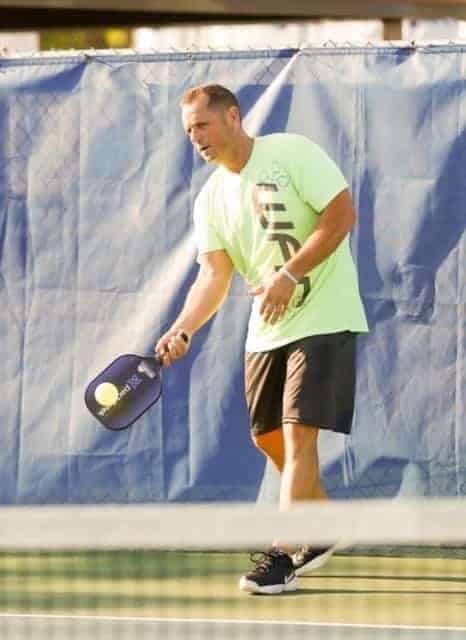
By hitting deep you keep your opponent from getting to the net for as long as possible. As a server, pushing the return team back as deep as possible is a crucial strategy.
All intermediate players do it.
The same can be said for the return of serve. As the return team, you’ve got the advantage to get to the no-volley zone line first; so use it.
By hitting a deep baseline hugging return of serve, you make it harder for the serving team to get to the kitchen line. The longer it takes the serving team to get to the net, the longer the return team has a big advantage.
Intermediate players always hit the first two shots deep!
Looking for a great paddle for intermediate players? Here are my favorites for this year.
Tip #3 – Know The Score And Pay Attention
This may sound elementary or even ridiculous but by knowing the score you automatically know what’s at stake and the circumstance you’re in during the match.
By knowing exactly whose serve it is and what the score is, you’re displaying the proper level of in-game attentiveness all intermediate and pro-level players expect.
Recreational players tend to forget who served last and who’s leading. For recreational play, that’s fine. It’s a light-hearted tone where fun is the main objective.
However, when you’re playing with intermediate players, the level of competition and consequently the level of focus is ratcheted up a few notches.
Intermediate players know the score and whose serve it is by default because their level of “in-game” focus is high.
If you’re trying to become an intermediate player, you’ve got to have the behaviors and habits of an intermediate player.
Having that focus and knowing the score at all times is one of those habits. So get into that habit.
Tip #4 – Be Dynamic, NOT Static
By that I mean you should always be moving. Intermediate players never look like statutes. They’re always moving and always adjusting to the direction of the ball.
A static player is one whose reaction time is half a second too late.
A dynamic player is one who’s always ready and in the right position. Intermediate players are ones that are moving, ready, and dynamic.
Your eyes, body, and paddle should be moving and shuffling with the ball at all times.
If you’re standing still, with your feet planted firmly and flat on the court with your paddle face pointed downward, you’re out of position.
You’re static.
Static players don’t win many points. Active, dynamic players win more points.
This brings me to my next intermediate-level tip.
Tip #5 – Always Be In The Pickleball “Ready” Position
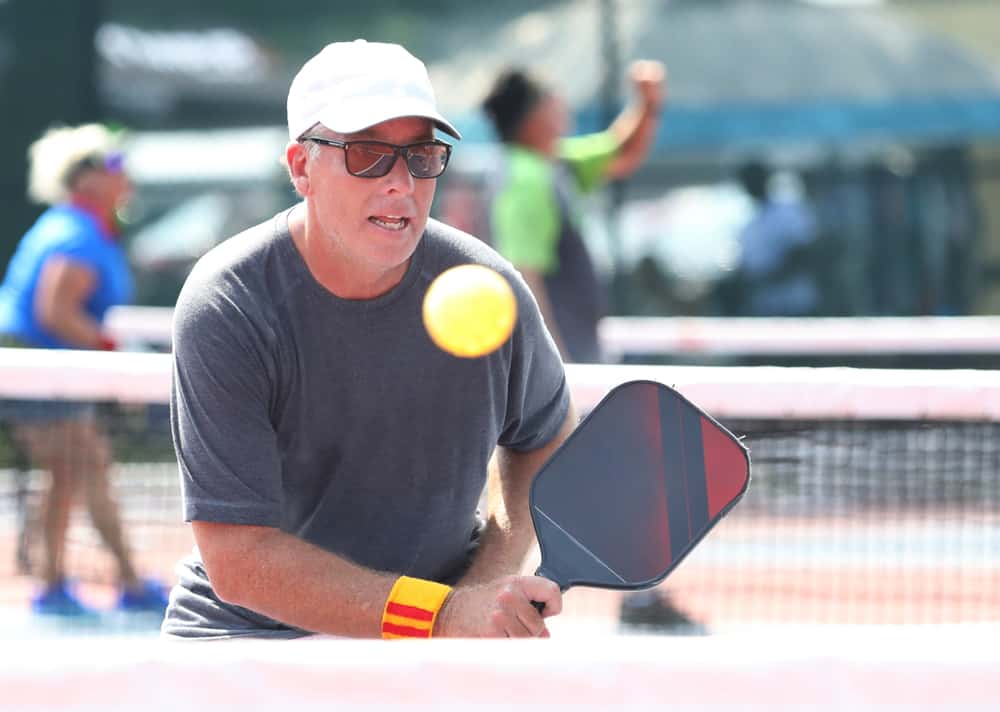
What does it mean to be “pickleball ready?” Well, it’s simple.
When you’re not actively hitting a shot, you should always have your paddle up and toward the center of your chest. This, along with being on the balls of your feet is the ready position in pickleball.
By being in the ready position with your paddle centered and up, you’ve put yourself in the best position to attack with a forehand or a backhand.
And with your paddle in the up position vs down with the head of your paddle facing the concrete, you save yourself precious fractions of a second.
You may think you can get your paddle up from a downward position to an upward, hitting-friendly position in time to hit a ball but trust me, it’s very difficult.
Intermediate players never give their opponents the opportunity to catch them with their guard down and out of position. They’re always in the ready position.
Having your paddle up and ready to strike may mean the difference between a hard shot hitting your hand vs hitting your paddle and keeping the point alive.
Tip #6 – Track The Ball With Your Paddle
An integral part to being in the ready position is to having your paddle up and in front of you.
But there is more to it than that.
Once you have your paddle up, get in the habit of tracking the movement of the ball with your paddle. Intermediate pickleball players always track the ball and mimic its path with their paddle.
It’s almost like there is an invisible string between the ball and your paddle. They’re always connected. I like to call it “paddle line of sight”.
One of the best tips for intermediate pickleball players is to always give your paddle line of sight on the ball no matter where it is on the court by following and tracking the ball.
Even if the ball isn’t being hit to you and your partner is getting most of the shots, always track the ball with your paddle.
This intermediate pickleball player tip also goes hand in hand with tip #4. If you’re tracking the ball with your paddle you should also be moving slightly as you track the ball. This body movement keeps you from becoming static.
Track the ball and move with its path so you’re always ready.
Related: Click here for my illustrated guide to basic pickleball strategies perfect for any player, complete with illustrated guidance in every photo!
Tip #7 – Know Where You’re Hitting The Ball Before You Hit It
Intermediate pickleball players do this tip more consistently than beginners or recreational players. They know where they’re going with the ball before they hit it.
Ask any beginner who’s just trying to learn the basics of the game. They’re not aiming anywhere beyond just “over the net”.
An intermediate pickleball player on the other hand should read their opponents and anticipate what shot would work best before they hit it.
An even more effective pickleball tip for intermediate players takes this concept even further – where you don’t just anticipate the best shot but you actually set yourself up for the best shot via your prior shots.
This is not easy but definitely something an intermediate player can accomplish within the nuances of a game depending on where and how your opponents are playing.
For instance, if one of the players on the opposite team is playing aggressively and reaching into their teammate’s area to get to shots, you can set them up.
Here’s how.
Hit soft, low dinks at the aggressive player but always down the middle. This forces the aggressor inward.
Then, on the next good forehand shot you’ve got, rip one down the open lane down the sideline to put it away.
This is an advanced tip that intermediate pickleball players use consistently. The more shots you can set up for yourself to then have an easy put-away shot, the better.
Intermediate pickleball players know this and execute this tip regularly.
Tip #8 – Always Force A Backhand Shot
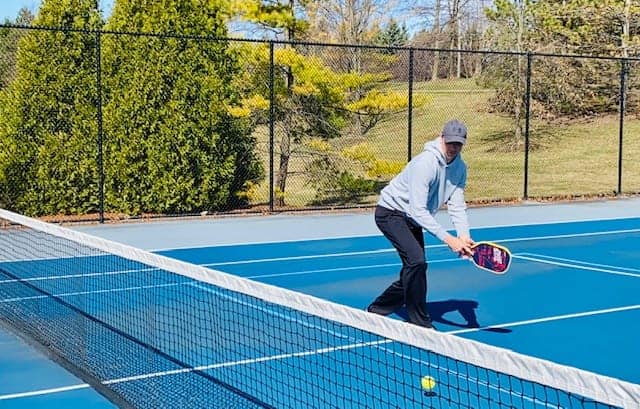
Chances are, most players you go up against will have a better forehand shot versus a backhand shot. So force your opponent to hit their weaker shot – their backhand.
Hitting to your opponent’s backhand is a fundamental pickleball tip. This intermediate pickleball tip is one I personally use every time I’m on the court.
And it’s especially useful when I’m going against someone who’s better than me and I need to even the playing field a little.
Not only do I aim to force a backhand shot on serves but I’ll do it whenever possible.
Return of serves, third shot drives, even dinks at the net. You name it and I’m aiming for my opponent’s backhand.
No matter what kind of shot is hit at me, if I can accurately hit it back where my opponent needs to execute a backhand volley or return, I do it.
I make it more difficult for them anytime the opportunity arises.
Any backhand shot, even for an intermediate player, is a more difficult shot. And the more difficult shots you force upon your opponent, the better.
If your opponents are having to hit difficult backhands and you’re hitting forehands, you’re going to win more points. The law of averages is in your favor.
Even if your opponent compensates and moves their feet in a way that allows them to get a forehand shot back, chances are their footwork has put them out of position and opened up a hitting lane for you.
Either way, this benefits you.
Backhand dinks are harder than forehand dinks. It’s harder to return a deep serve when it’s hit to your backhand. You get the idea.
The general concept is to force your opponent to hit a difficult shot and you’ve given yourself an advantage. Well, the easiest way to do that is to hit to their backhand and see if they can execute.
Tip #9 – Hit At Your Opponent’s Feet
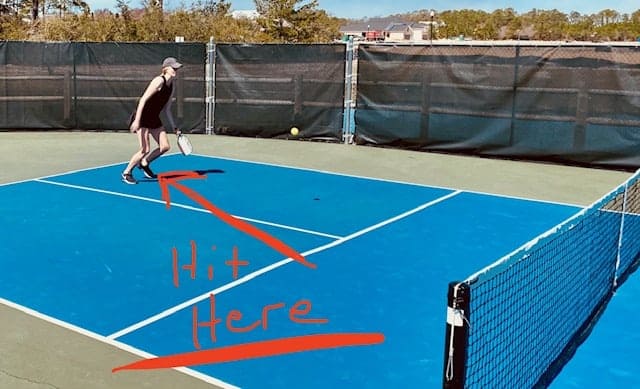
My brother, a tournament-level player, taught me this one. It’s never a bad shot if your opponent has to back up to accurately hit it back.
Put simply, hitting at your opponent’s feet forces a difficult return shot.
It doesn’t matter if you are serving or at the net dropping soft dinks, if you’re hitting at your opponent’s feet, you’re going to win more points.
However, I’ve found this intermediate-level pickleball tip to be especially useful and effective when at the net.
Why?
Because it makes the cardinal rule most pros live by more difficult to execute?
What rule is that you ask?
It’s the rule a lot of coaches and pros teach when at the net. It goes like this – don’t ever back up to hit a shot. Just hit it off the fly or volley if you can.
But when the ball is hit hard and at your feet you don’t have any other choice but to back up.
And any return is more difficult to execute when you’re backing up so the ball doesn’t hit your feet.
Pro Tip: Combine the last two tips and you’ve got a killer strategy that will win you a lot more games. Aim at the feet of your opponent’s backhand.
If your opponent is right-handed, then blast every shot you can at their left foot. Force them to back up (so it doesn’t hit their left shoe) and force a backhand shot. This is a killer combination.
A backhand shot of any kind while stepping backward is an awkward and extremely difficult shot for even the best players to hit.
Tip #10 – Hit At The Weaker Opponent As Much As Possible
US Gold Medal Champ Simone Jardim has openly admitted that in doubles play, hitting to the weaker opponent is a strategy often used. Especially in mixed doubles.
As unfair or just plain mean as it sounds, the truth is the weaker opponent, regardless of gender, is often targeted.
So why not use that strategy yourself?
When you’re playing doubles and it’s clear who the weaker opponent is, pepper that player with difficult shots like the ones we’ve talked about above.
Don’t be bashful. This is an intermediate-player pickleball tip that all experienced players implement.
Force the weaker player to beat you. It’s that simple.
Tip #11 – Hit At The Opponent That is Further Back
When playing doubles if you notice that your opponents are not lined up parallel to one another – hit at the player who’s furthest back.
If they’re not lined up across from each other, you’ve recognized a critical error on their part.
So take advantage of it, and expose it.
When one opponent is not up at the net, but is actually sitting back between the baseline and the no-volley zone line – they are in the area of the court called “no-man’s land”.
The player in “no-man’s land” is the one player on the court who is the most out of position.
Here’s why.
If you’re stuck in the middle part of the court, it makes it harder to decide whether to volley a shot hit at you or back up further to allow a bounce.
Backing up further takes away the advantage of being at the net.
So if your opponents are not parallel, hit to the player who’s furthest back in order to keep them back.
Hit a shot at their feet and force them to decide – ground stoke or volley.
Bonus Pickleball Tip For Intermediate Players – Move As A Team
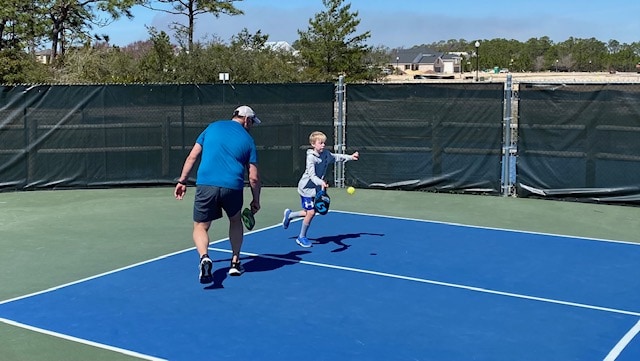
When playing doubles, it’s important to move on your side of the court together, as a team.
Watch any good professional doubles team, they are in sync and move as one. They always track the ball and move left or right horizontally across the court together.
Remember to always move together. And that applies to getting to the kitchen line too.
Tip #11 was about hitting to the player furthest back on the court. Well, this bonus pickleball tip for intermediate players is all about avoiding that mistake.
Avoid having one player up at the kitchen line and one player in “no-man’s land” by moving up to the kitchen line together.
If your teammate is stuck back hitting deep returns, stay back with them and gradually move up at the same time.
This will keep the other team from exposing a mismatched, misaligned team. In addition, it’s easy to get to balls that are hit down the middle when you’re lined up together.
Intermediate Pickleball Tips – Related Questions
How Do I Get Better At Pickleball?
Contrary to popular belief, the best way to get better at pickleball is to drill. Drill work has been known to improve muscle memory while on the court better than simply playing the game.
Playing game after game of pickleball will indeed improve your game but depending on the competition level, it may slow your development.
Drills to practice regularly are:
- Third shot drop drills where you stand deep and your partner stands at the kitchen line. Your partner hits quick shots at you while you practice dropping your returns into the no-volley zone.
- Dinking drills where you attempt to hit soft dunks at your opponent’s feet forcing them to back up.
Playing regularly will help you get better at pickleball but nothing allows you to jump a skill level like consistent drill work with a player at an equal or better skill level than you are.
Speaking of skill level, another way to get better is to play with and against people that are slightly better than you.
In addition, if you can’t do drills consistently, playing up a level in the competition will help you improve at pickleball quicker than playing with players at or below your skill level.
What’s The Difference Between An Intermediate Pickleball Player And A Pro?
Pro-level players and intermediate players both know where they want to hit the ball before they hit it. Their shots, for the most part, are planned.
However, the difference between an intermediate player and a pro is that a pro hits their predetermined shots at an 80% to 90% accuracy clip.
Intermediate players have an accuracy clip closer to 50%.
The shot attempts are similar in difficulty but the accuracy is what separates a pro from an intermediate player.
The intermediate-level player has the mental part of the game but doesn’t have the skill level yet that a pro does. Pros have both the mental part of the game and the skill required to hit shots at a higher success rate.
What Are 3 Key Things You Should Focus On In Pickleball?
After playing pickleball competitively for over 5 years, my top 3 keys to focus on are:
- Always keep the point alive if you can. A bad shot that goes over the net has a chance. A shot in the net never does.
- When in doubt, hit it low over the net and down the middle.
- Be patient. Aggressive players usually make more mistakes. Safe, low shots win points.
Pickleball Tips For Intermediate Players – Final Thoughts
I hope you’ve learned a few things and taken a few pickleball tips for intermediate players that you can implement on the court right away.
Intermediate pickleball players do a handful of these tips consistently.
They focus on these concepts and execute them regularly.
Sometimes the difference between a point won and a point lost comes down to simple execution of one or more of the tips I’ve outlined for you today.
Leave a comment and let me know which tip has improved your game the most. I’d love to hear from you!
Related: Here is another related article from Amazing Aces on intermediate strategy.

Welcome to TheVolleyLlama.com. My name is Keith, I’m just a lover of all sports that involve a racquet, net and a ball. I played competitive high school varsity tennis, love racquetball and my whole family plays pickleball regularly. I started this website to help give people like you the basics to learn these wonderful games.



